Shipwreck of Passenger Ship “Patris” (ex name “Saint Remi”)
-
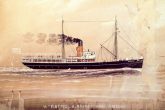
The passenger steam ship “Patris” during the period that it belonged to the resident of Galaksidi, A. Bobogiannis (work of A. Glika, Museum of Galaksidi) -
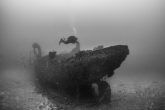
The stern of “Patris”. The davits of the left part are obvious (© 2014 www.wetklik.gr by Milonakis Kostas and www.grafasdiving.gr) -
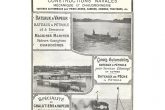
A flyer of the constructor of “Patris (ex name “Saint Remi”) E. Amblard & Cie Constructions Navales Mecanique et Chaudronnerie at Dieppe, France (© archive Antonis Grafas) -
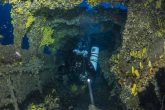
Investigating the superstructure of the ship (© 2014 www.wetklik.gr by Milonakis Kostas and www.grafasdiving.gr) -
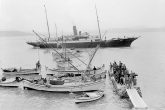
The passenger steam ship “Moschanthi Togia” (ex British yacht “Catania”), that jammed and sank “Patris” in the morning of June 15th 1927 (© archive Grigoris Belivanakis) -
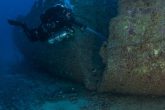
The big gap at the right side of the ship that was caused by the wedging of “Moschanthi Togia” and was the cause of the sinking of “Patris” (© 2014 www.wetklik.gr by Milonakis Kostas and www.grafasdiving.gr) -
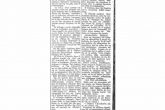
The first announcement for the accident and the sinking of “Patris” by the daily newspaper Empros . -
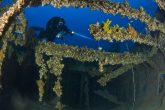
87 years have passed since its sinking and they have not affected very much the wreck’s condition that hasn’t got any special signs of collapse and impairment (© 2014 www.wetklik.gr by Milonakis Kostas and www.grafasdiving.gr) -
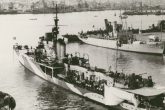
The steam ship “Moschanthi Togia” that jammed and sank “Patris” was one of the most historic ships of the Hellenic shipping. Here is as an antisubmarine UJ-2107 (right) with the Italian torpedo ship “Pegaso” at the port of Piraeus on 25.08 -
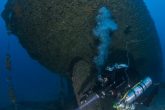
A diver at the area of the rudder and the propeller of “Patris” (© 2014 www.wetklik.gr by Milonakis Kostas and www.grafasdiving.gr) -
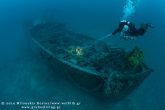
The steam ship “Patris” as it is today -
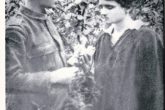
Konstantinos Ginakos, one of the two leasers of “Patris” with this wife Marika. Mr. Ginakos was one of the victims that got lost during the sinking of “Patris” (archive G. Chronis) -
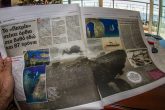
Publication in newspaper Elefteros tipos. -
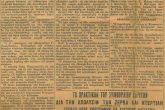
Piece of a newspaper that refers in details to the accident and the sinking of “Patris” (archive G. Chronis) -

Video 01.From the shipwreck Patris ( Saint Remi 1902). -

Video 02 from the shipwreck Patris ( Saint Remi 1902). -

Video 03.Interwiew George Chronis former director NCMR.
Passenger Ship “Patris” (ex name “Saint Remi”)
In June 4th 2011, Antonis Grafas and his diving team dived for the first time in an unknown – until then – wreck that they had detected a few time ago near the island of Patroklos in the Saronic Gulf. As it was later proved, this wreck was the small passenger steam ship “Patris” (ex French name “Saint Remi”) that sank in the morning of June 15th 1927 after being rammed by the passenger steam ship “Moschanthi Togia” (ex British name “Catania”) due to a human mistake.
“Patris” was constructed in 1902 at Dieppe of France as an iron fishing boat under the name “Saint Remi” by the E. Amblard & Cie Constructions Navales Mecanique et Chaudronnerie a Dieppe company. The total length was 32m and its tonnage was 161tonnes. In 1911 it was bought by the brothers shipowners Chatzikonstanti, it was reconstructed as a passenger ship and it was registered to Piraeus under the name “Patris”, a name that was kept until its sinking. After several changes of ownership, the ship was sold to the candidate member of the Parliament Mr. Apostolos Zouzoulas in 1923, under the ownership of which the ship was until its loss. In June 1st 1927, Apostolos Zouzoulas chartered the ship for 15.000 drachmas/per month for 3 months to Konstantinos Ginakos and Diomedes Aiginitis who used it for several trips between Piraeus and the islands of Paros and Naxos. They had already realized two trips and the last one, during which the ship sank, was the third trip that “Patris” realized under the supervision of Ginakos and Aiginitis.
The accident
At 22.50 of June 15th 1927, “Patris”, with 16 passengers in total [1] and under the administration of the captain G. Kostallou, sailed from Piraeus heading to Naxos. At 01.30 of June 16th and while it was passing from the south-west cape of the island of Patroklos, they realized that the ship was moving opposite to the course of the passenger ships “Moschanthi Togia” and “Tinos” that they were coming from Siros heading to the port of Piraeus.
In a small distance behind the mentioned ships, the passenger steam ship “Angeliki” of the marine company Gianoulatos was coming from Siros as well.
As the press mentions, “Moschanthi Togia” [2] of the steam ship company of Togia brothers having as responsible of the bridge during the crash the assistant captain Mr. N. Chavlopoulos and “Tinos” of the D. Iglessi brothers company with Captain Mr. I. Kantouna were competing in a speed course sailing with a speed of 13-14 knots [3].
“Patris” trying to avoid the crash and not being able to pass between the two ships turned to the left exposing its right side to “Moschanthi Togia” that was coming with a great speed. Due to the great speed and the small distance between the two ships, “Moschanthi Togia” crashed and jammed with force into the right side of “Patris”.
Directly after this and during their effort to remove “Moschanthi Togia” from “Patris”, water came into the latter that got too heavy and sank very quickly with ten losses in total [4].
The daily press of that period explains thoroughly and in detail the accident [5]:
“Late the night before yesterday the steam ships “Moschanthi” of the steam ship company Togia and “Tinos” of the brothers D. Iglessi company left from Siros with all passengers. Later the same night, the steam ship “Angeliki” of Mr. Gianoulatos left from Siros to Piraeus as well […]. At 02.00am and at the south-west side of the island of Gaidouronisi [6], the steam ship “Patris” suddenly appeared. At that moment, the steam ships “Moschanthi Togia” and “Tinos” were sailing in parallel having a distance of 200-300m between each other. “Moschanthi” was from the side of the land and “Tinos” was from the side of the sea. “Patris”, being in front of these two ships coming towards, decided at first to pass through them having “Tinos” at its right side and “Moschanthi” at its left side […]. Unfortunately, the speed of both ships was high and their distance was small. As “Patris” was afraid of an upcoming crash with “Tinos”, turned to the left and honked to “Moschanthi Togia”. The assistant captain of “Moschanthi” Mr. N. Chavlopoulos that was steering the ship at that time and being afraid of such a sudden and dangerous movement of “Patris” seeing an upcoming and unavoidable crash called to danger and ordered to go quickly backwards while he turned the rudder to the left in order to change course. However, the distance was small and the crash was terrifying. “Patris” by turning so suddenly created an angle of 45° as we say in the marine jargon. In this way, it exposed its whole right side to “Moschanthi Togia” whose bow hit “Patris” in the middle and exactly in the engine room where it was jammed. The ship inclined and sank within two minutes […].”
The causes and the consequences of the sinking
The captain of “Patris”, Mr G. Kostalos, referring to the causes of the accident mentions the below [7]: “At 01.50 I was at the south west side of Gaidouronisi with a speed of 8 miles per hour. At first I saw two white lights and then two more. I realized that they were the ships of the islands. They had a speed of 12-13 miles. They were almost 800m away. Then I saw the red light of “Moschanthi”, i.e its left light, and then the green one of “Tinos”. Imagine that their between distance was not more than 50m. “Moschanthi” was near the land and I esteemed that the distance of 800m that separated us, almost half a mile, was a matter of 2,5 minutes, as they had a speed of 12 miles and we had a speed of 8 miles, i.e 20 miles in total. If I had taken the rudder, I would have crashed with “Tinos”. I could not pass between them so I thought to throw the ship on the island that was on my left. I honked twice in order to notify “Moschanthi” that I was heading to the left and despite the rules I turned the rudder. However, the other ship jammed into us. If he had taken the rudder to the left as well and he had stopped the engine, we would have avoided the crash. He did not even honk. Probably, he was very surprised and he crashed into “Patris”. Also, due to the backward movement that he did, the water entered and my ship got heavy on its stern. I gave to all crew instructions but as the stern was getting even heavier the bow started going up.”
From the side of the marine company of Togia brothers that had a lawyer, a different version than the one of Kostallos was mentioned [8]: “We did what the rules are saying. They should not attribute to us any responsibility. “Moschanthi” honked several times in order to notify “Patris” for the danger and suddenly we saw “Patris” in a small distance trying at first to pass through “Moschanthi” and “Tinos” and then turning to the left having its right side exposed to us. “Moschanthi” immediately moved backwards but it was too late. Our bow crashed into “Patris”, jammed into the ship and when “Moschanthi” moved backwards all waters entered “Patris” through the gap that was created by the crash. After a while, “Patris” stern started to sink, so the ship inclined backwards, the bow got up and it disappeared.”
After the sinking of “Patris”, the captain of “Moschanthi Togia” ordered to launch the lifeboats in order to rescue the castaways. The competing steam ship “Tinos”, even though saw the crash of the two ships, continued its course to the Piraeus port without offering any help to the crew of “Moschanthi” during their life rescue mission ignoring the rules of the marine ethics. The coming steam ship “Angeliki” was the one that helped the crew of “Moschanthi” to rescue the castaways of “Patris”. After the arrival of all involved ships and castaways to the port of Piraeus, the responsible of the judicial department of the Port Authority of Piraeus Mr. Th. Konstantinidis along with the participation of the attorney Mr G. Chalkias, undertook the procedure of the questionings and the attribution of responsibilities.
According to their statements to the daily press [9]: “[…] the responsibility of the accident is mostly attributed to the assistant captain of “Moschanthi” Mr Chavlopoulos who was not supposed for any reason to turn to the right, instead he should have turned to the left as the captain of “Tinos” did. The latter was honored for being ready and prepared by the administration and the marine environment. As for the captain of “Patris”, he is honored as well for being ready because he turned to the left due to force majeure despite the rules and the danger of crashing into the rocks of the island.”
Also, the sub harbormaster of Piraeus attributed the charge for negligent homicide to the assistant captain of “Moschanthi Togia” that was on shift on the bridge and the charge for breaking the international marine rules to the captain of “Tinos” Mr I. Kantounas for not offering any help to rescue the castaways of “Patris”.
The wreck
The wreck of the passenger steam ship “Patris” is located in the sea bottom in an upright position. The maximum depth of the wreck is 73m and the minimum 65m. The possible axis of bow-stern has a southeast direction of almost 130°. The big gap in the middle of the ship at the right side of the wreck that was created by the crash and wedging of “Moschanthi Togia” bow is very obvious and it is the only gap that this wreck has.
87 years have passed since its sinking and they have not affected very much the wreck’s condition that is still in an upright position without having any signs of collapse and impairment.
The wreck of the small passenger steam ship “Patris” is not a loss that turns out from any war action, as so many other wrecks in the Greek seas. However, the fact that it comes from the middle war period during which the Greek merchant shipping was in a renewal period after the great losses of the World War I, makes it an important witness of that period, firstly because of the special constructing and technical characteristics and secondly due to its participation to an accident that occurred by a habit that, sometimes is still active nowadays: the competition and the participation in unofficial speed races of ships of the Greek passenger coastal shipping.
Another fact that makes the “Patris” wreck a significant referral point of the Greek merchant navy is the determinant involvement to its sinking of the passenger steam ship “Moschanthi Togia” (later it was called “Milos”) that participated during the war as an antisubmarine UJ-2107 in the operations of the German Kriegsmarine until its sinking during an allied air bombing in autumn 1944.
DG
References, Supplements, Clarifications
[1] The 16 passengers were the 12 crew members, 2 ship leasers (K. Ginakos & D. Aiginitis) and 2 passengers, the one of which was an animal merchant having 35 sheep and his assistant. Even though the “Patris” crew had 14 men, 2 of them, the second engineer K. Thomakos and the coal man Ch. Kiriazis, did not board on “Patris” when the ship sailed. The initial information about an English engineer of the emery mines in Naxos on the deck of “Patris” was later negated by the captain of the ship G. Kostalos (see SKRIP issue 17.6.1927).
[2] The passenger steam ship “Moschanthi Togia” with a length of 62m and tonnage 598 tonnes was constructed in 1895 as a British yacht “Catania” in Glasgow, Scotland. In 1922, it was bought by the brothers Togia, it was transformed to a passenger ship and was named “Moschanthi Togia”. In 1930, it was bought by the National Steam Shipping and in 1932 it was named “Milos”. After the declaration of the Greek-Italian war, it was commandeered by the Greek government on 29.10.1940 and it was used as a troopship. In April 6th 1941 while it was at the port of Piraeus, a massive explosion took place at the British cargo ship “Clan Fraser” and as a result it underwent huge damages so it was not useful anymore. After the occupation of Greece by the German Army, the ship was considered to be a war asset and it was included in the German War Navy (see Kriegsmarine) as a costguard vessel under the code 13V3 for the Coastal Protective Fleet of Crete at the beginning and then, from February 1942, as an antisubmarine under the code UJ-2107 for the 21st Antisubmarine Fleet. From January 1943, its whole alteration started by DWK (Deutsche-Werft Kiel) at the dock yard of Salamina. The ship, whose repair never was completed, was destroyed at Salamina in September 15th 1944 during an allied air bombing. After the war, the ship was broken up and sold as metal by the Organization of Wreck Floating.
[3] “The newspaper of politics and news Skrip ” issue 17.6.1927.
[4] The ten persons that did not survive from the accident were: I. Chatzikonstantis from Chios, first engineer, 38 years old, married – P. Bafitis from Paros, stoker, 23 years old, married – K. Xenos from Paros, stoker, 25 years old – I. Sirmas from Spetses, boatswain, 27 years old, married – G. Kidoneas from Lefkes, Paros, steward, married and father of 6 children – K. Desipris from Paros, sailor, 43 years old – K. Ginakos from Paros, leaser of the ship – I. Pamvotas from Naxos, animal merchant, married – D. Giafasouris from Naxos, employee of Pamvotas – a mailman of unknown personal details.
[5] “Daily National Newspaper Empros” issue 17.6.1927.
[6] It is the island of Patroklos that is also known under the name “Gaidouronisi”.
[7] Supra [3]
[8] Aut.
[9] “The newspaper of politics and news Skrip” issue 18.6.1927.
Archives and bibliography
“Daily National Newspaper Empros”, dates 17 & 18.6.1927
“The newspaper of politics and news Skrip”, dates 17 & 18.6.1927
“Rizospastis” dates 17 & 18.6.1927
Lloyds Register of Shipping
KTB der 13. K Kustenschutzfolttille Kreta, NARA
KTB der 21. UJ-Flottille, NARA
Groner, Erich / Jung, Dieter / Maass, Martin: Die deutschen Kriegsschiffe 1815-1945, Bd. 8/2, Verlag Bernard & Graefe, 1987
Malakassis Ioannis (Corrections): Archive I. Melissinos, Reservist of the Permanent Commander
Hellenic Navy – The Navy during the World War II – The total contribution of the Hellenic Merchant Shipping (Sailing and Steam Ships) 1940-1945, volume A, University of Ioannina, 1995.
Ntounis Christos: The wrecks of the Greek seas, volume A, Finatec, 2000.

